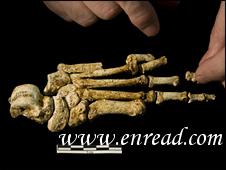Hobbits 'are a separate species' 矮人族“是一个独立的物种”
(单词翻译:单击)
Scientists have found more evidence that the Indonesian "Hobbit" skeletons belong to a new species of human - and not modern pygmies.
科学家发现了更多的证据证明印尼“矮人族”的骨架属于人类的新分支 ,而不是现代侏儒。
The Hobbit's foot is in many ways quite primitive1
The 3ft (one metre) tall, 30kg (65lbs) humans roamed(漫游,闲逛) the Indonesian island of Flores, perhaps up to 8,000 years ago.
Since the discovery, researchers have argued vehemently2(热烈地) as to the identity of these diminutive3(小的,小型的) people.
Two papers in the journal Nature now support the idea they were an entirely4 new species of human.
The team, which discovered the tiny remains5 in Liang Bua cave on Flores, contends that the population belongs to the species Homo floresiensis - separate from our own grouping Homo sapiens(智人).
They argue that the "Hobbits" are descended6 from a prehistoric7(史前的) species of human - perhaps Homo erectus - which reached island South-East Asia more than a million years ago.
Over many years, their bodies most likely evolved to be smaller in size, through a natural selection process called island dwarfing8(矮化病), claim the discoverers, and many other scientists.
However, some researchers argued that this could not account for the Hobbit's chimp(黑猩猩)-sized brain of almost 400 cubic cm - a third the size of the modern human brain.
Disease theory
This was a puzzle, they said, because the individuals seem to have crafted complex stone tools.
They said the Hobbits were probably part of a group of modern humans with abnormally small brains.
One team led by William Jungers from Stony9 Brook10 University in the US analysed remains of the Hobbit foot.
They found that, in some ways, it is incredibly human. The big toe is aligned11(对齐的,均衡的) with the others and the joints12 make it possible to extend the toes as the body's full weight falls on the foot, attributes not found in great apes.
But in other respects, it is incredibly primitive(原始的). It is far longer than its modern human equivalent(等价的,想等的), and equipped with a very small big toe, long, curved lateral13 toes, and a weight-bearing structure that resembles that of a chimpanzee(黑猩猩).
So unless the Flores Hobbits became more primitive over time - a rather unlikely scenario14(情节,剧本) - they must have branched off the human line at an even earlier date.
In another study, Eleanor Weston and Adrian Lister of London's Natural History Museum looked at fossils of several species of ancient hippos(河马). They then compared those found on the island of Madagascar with the mainland ancestors from which they evolved.
"It could be that H. floresiensis' skull15 is that of a Homo erectus(直立人) that has become dwarfed16 from living on an island, rather than being an abnormal individual or separately-evolved species, as has been suggested," said Dr Weston, a palaeontologist at the museum.
"Looking at pygmy(矮人,侏儒) hippos in Madagascar, which possess exceptionally small brains for their size, suggests that the same could be true for H. floresiensis , and that (it could be) the result of being isolated17 on the island."
 收听单词发音
收听单词发音
1
primitive

|
|
| adj.原始的;简单的;n.原(始)人,原始事物 | |
参考例句: |
|
|
|
2
vehemently

|
|
| adv. 热烈地 | |
参考例句: |
|
|
|
3
diminutive

|
|
| adj.小巧可爱的,小的 | |
参考例句: |
|
|
|
4
entirely

|
|
| ad.全部地,完整地;完全地,彻底地 | |
参考例句: |
|
|
|
5
remains

|
|
| n.剩余物,残留物;遗体,遗迹 | |
参考例句: |
|
|
|
6
descended

|
|
| a.为...后裔的,出身于...的 | |
参考例句: |
|
|
|
7
prehistoric

|
|
| adj.(有记载的)历史以前的,史前的,古老的 | |
参考例句: |
|
|
|
8
dwarfing

|
|
| n.矮化病 | |
参考例句: |
|
|
|
9
stony

|
|
| adj.石头的,多石头的,冷酷的,无情的 | |
参考例句: |
|
|
|
10
brook

|
|
| n.小河,溪;v.忍受,容让 | |
参考例句: |
|
|
|
11
aligned

|
|
| adj.对齐的,均衡的 | |
参考例句: |
|
|
|
12
joints

|
|
| 接头( joint的名词复数 ); 关节; 公共场所(尤指价格低廉的饮食和娱乐场所) (非正式); 一块烤肉 (英式英语) | |
参考例句: |
|
|
|
13
lateral

|
|
| adj.侧面的,旁边的 | |
参考例句: |
|
|
|
14
scenario

|
|
| n.剧本,脚本;概要 | |
参考例句: |
|
|
|
15
skull

|
|
| n.头骨;颅骨 | |
参考例句: |
|
|
|
16
dwarfed

|
|
| vt.(使)显得矮小(dwarf的过去式与过去分词形式) | |
参考例句: |
|
|
|
17
isolated

|
|
| adj.与世隔绝的 | |
参考例句: |
|
|
|





